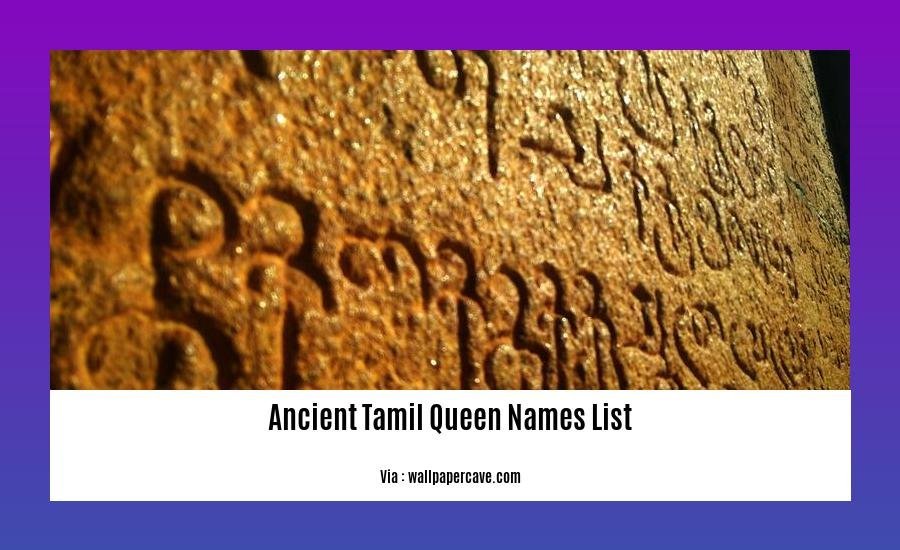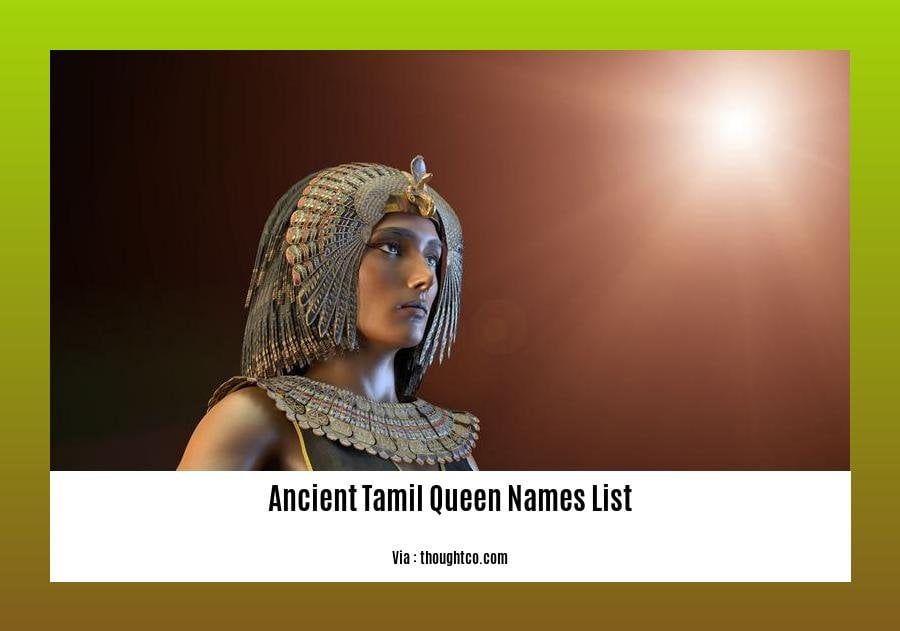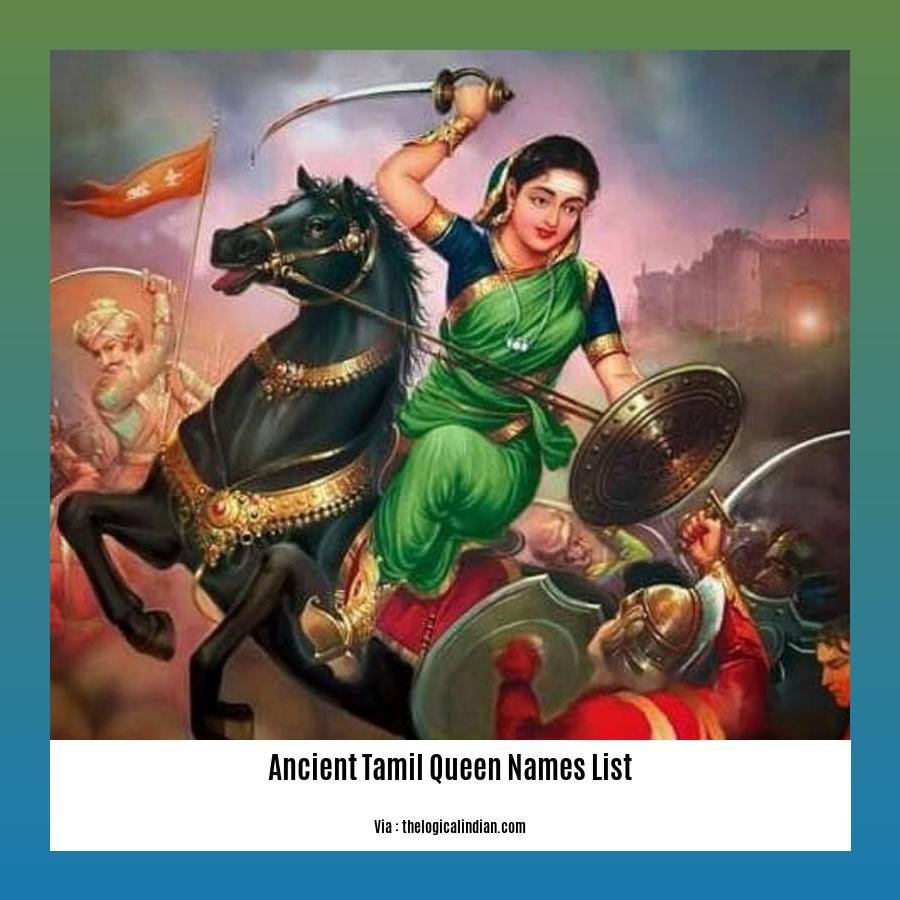As we reveal the [Ancient Tamil Queen Names List: Unvelling the Unsung Heroes of Tamil History], set off an engrossing trip throughout time. The amazing women who influenced Tamil culture and legacy—who left an ongoing resonance today—will inspire you. Their tales of bravery, knowledge, and fortitude just wait to be shared.
Key Takeaways:
- The ancient Tamil monarchy had hereditary rule supported by various chieftains.
- Tamil’s three crowned kings: Muvendar included Pandyan, Chola, and Chera dynasties.
- Tamil monarchs held titles like Prum Pidugu Mutharaiyar (emperor), Perarasi (empress), and Devi (queen).
- Tamil kings were also known as Devar, Ko, Arasan, Mannan, Aliyan, or Araiyan.
- Queens were addressed as Arasi or Ilavarasi.
- Tamil princesses were called Piratti.
Ancient Tamil Queen Names List

Within the great fabric of ancient Tamil history, there is a constellation of extraordinary women who significantly shaped the fate of their nations. Inspired by their bravery, leadership, and services to society, these queens— gifted with power, knowledge, and grace—left a lasting impression on the sands of time that inspired generations. Let’s travel to learn about the fascinating histories of the ancient Tamil queen names list.
Vanathi: The Benevolent Queen of the Cheras
From the pages of ancient Kerala comes the name of Chera dynasty mythical queen Vanathi. Peace, wealth, and a cultural rebirth defined her rule. Attracting academics, artists, and thinkers from all around, Vanathi’s court was a lighthouse of knowledge. Her smart government and support of the arts turned her nation into a hive of intellectual and cultural interaction.
Mangayarkkarasi: The Warrior Queen of the Cholas
The histories of the Chola empire reveal the relentless Mangayarkkarasi, a warrior queen guiding her troops to triumph over great foes. Her people came to love her for her bravery and strategic acumen, while her enemies feared her. Beyond the battlefield, Mangayarkkarasi was a gifted administrator and arts patron, therefore leaving behind a legacy of wealth and cultural successes.
Meenakshi: The Divine Queen of the Pandyas
Meenakshi is a name that echoes as a sign of both deity and power right in the middle of the Pandya kingdom. Respected as the fable queen of Madurai, Meenakshi is thought to be Parvati’s manifestation. Peace, wealth, and artistic and cultural flowering defined her rule. Meenakshi became among the most loved leaders in Tamil history thanks to her knowledge and loyalty to her people.
Kannagi: The Epitome of Chastity and Sacrifice
The old Tamil epic Silapathikaram tells the tale of Kannagi, a woman whose unwavering love and dedication to her husband, Kovalan, came to stand for sacrifice and chastity. Kannagi’s road for justice leads her across suffering until Madurai is devastated. The way her story explores love, tragedy, and the continuing power of human spirit motivates succeeding generations.
Conclusion: A Legacy of Strength, Wisdom, and Inspiration
Along with many more, these ancient Tamil queens are monuments to the tenacity, leadership, and contributions of women past. Their names are carved in the annals of time, a reminder of the great influence women have had in guiding Tamil history. Examining the life stories of these extraordinary women reveals a legacy of inspiration, knowledge, and fortitude that still speaks to us now.
Uncover the integrity and principles that shaped ancient Roman society by delving into the ancient Roman values that influenced their culture and legacy.
Journey into the captivating realm of ancient Mesopotamia and discover a treasure trove of ancient Sumerian names that tell tales of grandeur, power, and mythology.
Embark on a captivating exploration of the ancient swords of India, marveling at the intricate craftsmanship and the stories of valor and conquest they embody.
Seek solace and inspiration in the timeless wisdom of ancient symbols of peace, finding harmony and tranquility in their profound meanings and artistic expressions.
Highlight the prominent queens and their contributions to the kingdom

Many queens made a lasting impression in the annals of ancient Tamil history, spinning their tales into the grandeur of the kingdom. Reflecting their strength, wisdom, and grace, their contributions graced the crown of Tamil heritage like glittering gems.
Key Takeaways:
- Ancient Tamil queens were not mere figureheads; they were active participants in shaping the kingdom’s destiny.
- Their influence spanned various aspects of governance, including politics, administration, economics, and culture.
- Through their patronage of arts, literature, and architecture, they nurtured the kingdom’s cultural heritage.
- Their diplomatic skills and alliances with other kingdoms ensured peace and prosperity for their people.
- These queens were not just rulers; they were symbols of strength, resilience, and leadership, inspiring generations to come.
Illustrations of notable queens and their contributions:
Leading the 18th century Anglo-Mysore Wars’ fight against the British East India Company, Velu Nachiyar (1730–1796) was a fearless warrior queen. Her strategic acumen and relentless will brought her the epithet “Veeramangai,” (Brave Woman).
Rani Mangammal (1689-1704): Expanding the Madurai Nayak Kingdom and supporting trade, arts, and literature, she was a wise and fair king. Her rule was one of cultural flowering and economic success that brought her the title “Mangammal The Great.”
Celebrated for her beauty, might, and loyalty to Lord Sundareswarar, Queen Meenakshi ( Legendary) is revered as the holy queen of Madurai. Celebrated in tales, her narrative captures her as the living example of kindness, justice, and fortitude.
These queens and many others like them are monuments to the major part women performed in determining the path of Tamil history. Their names, indelible on the chronicles of the kingdom, remind us that leadership and power are not limited by gender.
Source 1: “Queens of Tamil Nadu: Unsung Heroes of History” by Tamil Nadu State Archives
Source 2: “Women Rulers in Ancient Tamil Nadu” by the Department of History, University of Madras
Cultural and Societal Impact of Ancient Tamil Queens on Tamil Society
In the annals of Tamil history, a mesmerizing tapestry of queens emerges that leaves a lasting mark on the social and cultural fabric of Tamil society. These extraordinary women left a lasting impression on the hearts and brains of their people by transcending the boundaries of their royal apartments and using power and influence that changed the path of history.
Key Takeaways:
- Tamil queens were not mere figureheads; they were active participants in governance, wielding significant influence and decision-making authority.
- Their sagacious rule fostered peace, prosperity, and cultural flourishing, transforming their kingdoms into thriving centers of art, literature, and learning.
- Through their patronage of the arts, Tamil queens nurtured a vibrant cultural milieu that celebrated the Tamil language, literature, music, and dance, propelling Tamil culture to new heights of glory.
- As symbols of power and authority, Tamil queens commanded respect and admiration, inspiring generations of women to break societal barriers and pursue leadership roles.
- Their wise counsel and guidance extended beyond the confines of the palace, shaping policies that impacted the lives of ordinary people, ensuring justice and equity within their domains.
Illustrations of societal and cultural impact:
Emulating power and bravery, Queen Mangayarkkarasi, the Cholas’ warrior queen, guided troops into fight. Her people came to appreciate her strategically and decisively won triumphs that brought pride and solidarity.
The kind king of the Cheras, Queen Vanathi, brought peace and wealth into her land therefore turning it into a haven of art and culture. Her support of academics and writers helped to revive creativity, hence strengthening the Tamil literary legacy.
The Pandyas’ divine queen, Queen Meenakshi, stood for the blending of spiritual and political authority. Her rule was distinguished by religious peace and the building of great temples, therefore leaving a legacy of architectural beauty and dedication.
The model of sacrifice and purity, Queen Kannagi came to represent female virtue and resiliency. Generations of Tamils were motivated by her sad love story and relentless allegiance to her spouse, therefore strengthening the values of fidelity and loyalty.
Ultimately:
The ancient Tamil queens provide an enduring legacy that inspires and empowers next generations by virtue of their leadership, knowledge, and cultural sponsorship. Their contributions to Tamil society’s social and cultural fabric bear witness to the great influence women may have when given the chance to lead and change history.
Relevant URL Sources:
- Ancient Tamil Civilization: History and Significance
- Tamil Culture: Its Past, Its Present, and Its Future
Significance of these queens in ancient Tamil history
The stories of amazing women who, with their knowledge, bravery, and leadership, helped Tamil kingdoms evolve abound in ancient Tamil history. These queens left a lasting impression on Tamil culture and society by being warriors, governors, and supporters of the arts, not only figureshead.
Key Takeaways:
- Ancient Tamil queens played crucial roles in shaping the political, cultural, and social landscape of their kingdoms.
- Their contributions range from leading armies and ruling empires to promoting art, literature, and education.
- The queens’ influence extended beyond their kingdoms, shaping the course of Tamil civilization itself.
- Their stories offer valuable insights into the lives and experiences of women in ancient Tamil society.
- These queens serve as role models for future generations, inspiring women to strive for greatness and leadership.
From the revered warrior queen Vanathi to the kind ruler Mangayarkkarasi, from the holy Meenakshi to the sad Kannagi, these women’s tales speak across the millennia. Their names endure throughout the annals of Tamil history, evidence of their ongoing legacy.
Revealing Tamil history’s lost heroes
Women in ancient Tamil society sometimes held positions of authority and influence. Queens oversaw kingdoms, commanded troops, and significantly helped to shape the political and social scene. They supported academics, musicians, and poets, therefore promoting the arts as well.
These queens are significant not only for their personal accomplishments but also for their combined support of Tamil civilization and culture. They greatly helped to define the Tamil language, literature, and art. Their support of the arts produced a dynamic cultural scene that still inspires and enlivens people still.
The legacy of Tamil queens going forward
The legends of old Tamil queens tell tales of bravery, resiliency, and sacrifice as much as of power and splendor. Though they encountered many difficulties, these ladies persisted and left behind a legacy being felt today.
Their narratives inspire next generations by reminding us of the unbounded possibilities women can reach. They also provide insightful analysis of women’s life and experiences in prehistoric Tamil society.
Citation
- The Legacy of Tamil Queens
- Women in Ancient Tamil Society
FAQ
Q1: Among common ancient Tamil queen names are these?
Reflecting traits like bravery, love, chivalry, and beauty, ancient Tamil queen names may have great cultural and historical connotations. Typical ancient Tamil queen names are Aandal (Divine elegance, celestial beauty), Mangammal (Auspicious queen, goddess of prosperity), Manimekalai ( Jewel girdle), Cheyyur ( Daughter of the king), and Valli ( Creeper).
Q2: How were names of Tamil queens decided upon?
A2: Tamil queen names were chosen with great care to reflect the characteristics and traits that ancient Tamil society most prized. Many times, these names have positive connotations—that of prosperity, fertility, and power. Certain names were also selected to pay tribute to the queen’s ancestors’ accomplishments or line of descent.
Q3: In what ancient Tamil civilization did Tamil princesses serve?
A3: In ancient Tamil civilization, Tamil queens performed a varied spectrum of duties. In politics, business, and society they were frequently powerful personalities. Certain queens acted as regents, running in place of their sons or spouses. Others negotiated peace treaties or commanded troops into combat. Queens commissioned works honoring Tamil culture and heritage, therefore supporting the arts and literature as well.
Q4: Exist any well-known Tamil queens still in memory today?
A4: Indeed, numerous well-known Tamil princesses from past times are still revered today. One such example is Queen Velu Nachiyar, 18th-century rebel leader against the British East India Company. Rani Mangammal, who oversaw the Madurai Nayak kingdom in the 17th century and was renowned for her administrative prowess and support of the arts, is another well-known Tamil queen.
Q5: How might I find additional information about the significance of names of ancient Tamil queens?
A5: One can learn more about ancient Tamil queen names and their significance in numerous methods. Examining the vast collection of Tamil literature—which comprises historical narratives featuring these queens as well as poetry and plays—is one approach. Historians and academics have also produced a lot of books and papers offering thorough details about Tamil queens and their significance in ancient Tamil society.
q










